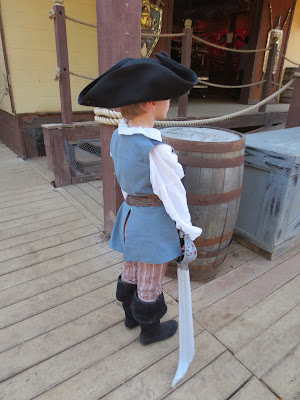For the All Hallow's Eve weekend of the Texas Renaissance Faire this year, I decided to make my wee boy a pirate costume. I also thought it would make a great entry for the "masquerade" challenge in the Historical Sew Fortnightly since it is a bit of a fantasy version of 18th c. boys' clothing. Luckily, he already had a shirt which I had made for the HSF "white" challenge, so all I needed to do was make a waistcoat, breeches, and a few piratey accessories.
The waistcoat is a modified version of the Mill Farm boys waistcoat pattern. I extended the bottom edge in the front and back to make longer flaps, rounded the neckline, and enlarged the pockets a little more. I am not very knowledgeable about 18th c. men's waistcoats, so I don't know if it is historically correct to make the back flaps as long as the front (I usually see them cut off shorter than the front), and I couldn't find many back-views of waistcoats from this period. But I've always thought the cut-off backs were a little odd looking when worn without a jacket, so I decided to make it long all the way around. The front of the waistcoat is made with blue-grey wool with a very small check, and the back is recycled from a man's linen shirt that I dyed to match. The whole thing is lined with tan cotton duck to give it a little more body. Although I wanted his outfit to be more of a "real" looking pirate instead of the bright and flashy Halloween pirates that you usually see, I think the silver buttons definitely add a bit of pirate panache as a finishing touch.
His breeches are made from a vintage Halloween pattern from the late 1960's, which made them really fun for me because I love working with vintage patterns. They ended up fitting him great, and the construction is worlds better than most modern Halloween patterns. The original pattern does use a zippered fly instead of a buttoned fall-front, but I thought the buttons at the knees were a really nice historical touch. The pattern actually calls for a buckle on the knee strap too, but I used mother-of-pearl buttons for all of it because I didn't have the right sized buckles in my stash. The pants are made out of striped linen that was recycled from a pair of my old capris, and I used some checked cotton for the waist and leg facings, which makes me happy even though nobody will ever see it. All of the materials and buttons for his costume came from my stash and from recycled clothes.
For his accessories, I bought him a pair of cheap girls' boots from Target and added a flap of faux leather at the top to make them look like the bucket-boots that you always see in pirate movies. His shoes are probably the least historically accurate part of his costume, but they are cute and he has a lot of fun wearing them, so what the heck.
I also took a large-brimmed wool hat blank and wired and bound the edge, then I tacked the brim up into a tricorn shape. My son's one request was that he have a skull and crossbones on his hat, so I made a rosette out of the selvage edge of some black corduroy (I love how the selvage has a fringed look to it), and then I tacked on a pressed-brass skull that I found on etsy.
We finished it all off with a paisley scarf for his sash, an old belt, and a variety of toy pirate weapons and bags-o-loot. I'm really happy with the way it all turned out, and I had a wonderful time playing pirates with my boy at faire.





























